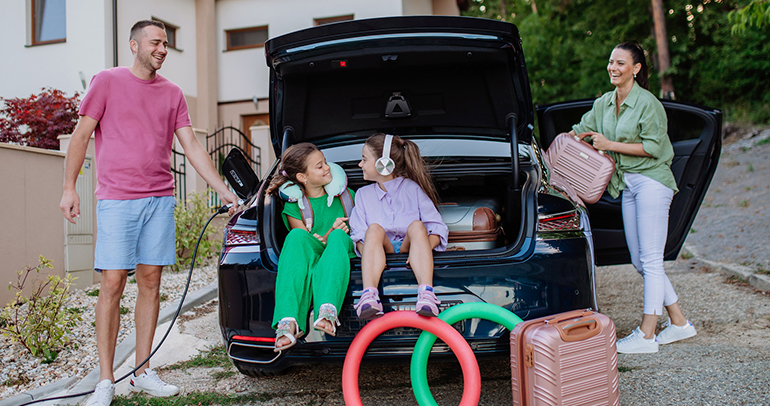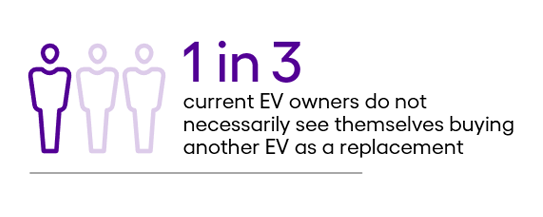
Electric vehicle (EV) adoption in Europe has gone past the Innovator stage, is well into the Early Adopter typology, but awaits general acceptance in the Early Majority group. It is the transition into this latter group that may make the prospect of return on investment (ROI) appear on the horizon for automotive original equipment manufacturers (OEMs).
But how quickly will that ROI come into view if the most progressive customer groups on the EV adoption curve are not unconditional advocates?
In 2022, Escalent’s second annual EVForwardTM Europe study revealed more than one-third of current EV owners do not necessarily see themselves buying another EV as a replacement. Of these unsure owners, 40% viewed EVs as still being a work in progress while a further 12% thought EVs are a passing fad.

This feels like an extraordinary dynamic among consumers most open to new ideas.
Surveying more than 10,000 new-car buyers across the UK, Germany, France, Italy and Spain, EVForward Europe also shows that more new-car buyers know someone who owns an EV than in 2021—what happens if less-than-enthusiastic EV owners spread the word among their peer group? Does the tricky-to-sell-to Early Majority become even more difficult to reach?
This blog aims to consider what forms of varied support may be needed to make the prospect of EV adoption look more reassuring and rewarding—in other words, how OEMs and EV stakeholders can create an “EV easy” mindset among consumers.
Four Areas of Focus to Make EV Adoption and Ownership Easier
1. The Nature of EV Journeys
One of the first things to address is the nature of journeys taken by our less enthusiastic EV owners. If anything, this less enthusiastic group works their vehicles less than EV-positive owners by taking shorter commutes and fewer longer journeys. Thus, EVs can realistically fit their range needs.
However, we continue to see that car shoppers’ emotions can inflate perceived range needs to unrealistic levels. Therefore, it is critical for automakers and EV stakeholders to educate and reassure new-car shoppers about the reality of managing EV journeys.
2. Resources for EV Charging
According to our findings, most new-car buyers would prefer home charging to be a large part of their charging behavior. However, the type of home property and surrounding environment can make home or public charging more or less challenging.
EV providers and stakeholders need to ask themselves:
- Are EV owners provided with sufficient resources and support to solve their charging problems?
- If not, what can we do to solve this?
- Additionally, what would make a public charging site more accessible, desirable and comfortable?
EVForward Europe does indicate that although home parking characteristics are similar across both groups of owners, there are some differences in the charging equipment used. Greater dependency on regular 240V plug sockets serves to limit the amount of charge that can be taken on—potentially imposing stresses on and disruptions to owners’ regular daily schedule.
In scenarios where private wall box charging installation is impractical, what kind of support can be offered to create practical charging strategies for EV owners? This has implications for both customer relationship management and onboard software.
3. EV Buyer Motivations and Ownership Experience
EVForward Europe has identified six persona groups of future EV buyers in Europe that have diverse perspectives on electric vehicles. Three of those groups view EVs positively but have distinctly different motivations when it comes to EV adoption.
Irrespective of whether entry into the EV world is triggered by an appetite for technology, social responsibility or other motivations, it is important that the different personal rewards offered by EV ownership correspond with the advantages future EV buyers anticipate. To do so will take a deep understanding of the different EV buyer personas.
4. Mental and Emotional EV Drivers
It is also evident that new-car buyers have very different emotional relationships with their vehicles—EV owners are no different.
Relationships can vary from considering a vehicle as a “Personal Assistant/Secretary” (that provides efficient, rational support) to an “Evil Twin” (whose focus is on the fun side of life) and even a “Lover” (which reflects an intense and passionate interaction). Much can be done in design—regarding aesthetic and human machine interface—to ensure an owner recognizes the role play signal they want from their car.
Furthermore, there is no doubt that owning an EV requires a significant amount of mental rewiring to accommodate different behaviors and considerations.
Some people relish a challenge, thinking along the lines of “show me an obstacle and I will find a way over it, under it or around it.”
For others, obstacles provoke stress, inducing thoughts and feelings of doubt, such as “there’s an obstacle in my way—perhaps I shouldn’t have chosen this route.”
All these complex emotional interactions point to a need for astute support that reaches far beyond point-of-sale reassurances. The kind of support required by the person who has a sleepless night worrying about how to manage their 200-mile journey the next morning is different from the carpe diem mindset.
Delivering Multifaceted EV Support
The critical support—via technology and traditional mediums—offered to EV buyers needs to become a multifaceted eco-structure that offers options for different consumer mindsets in different circumstances, so the EV user experience makes ownership “EV easy!”
We designed our EVForward Europe 2023 study, which is currently in field, to provide even deeper diagnostic perspective on both the user experience among EV owners as well as future EV adoption trends and desires.
If you’re interested in learning more about our EVForward Europe findings and how we can help you refine your EV strategy, please reach out to us by clicking the button below.
About EVForward™ Europe 2022
The second annual wave of the EVForward Europe study was conducted across five European countries: United Kingdom (n=1,941), Germany (n=2,011), France (n=1,723), Italy (n=1,915) and Spain (n=1,806). It had a market-representative sample of 9,396 respondents and included a survey that fielded from July to August 2022. Respondents were ages 18 to 80 with a primary vehicle model that’s 2016 or newer, and all intended to purchase a new vehicle within the next five years. Data were weighted by age and gender to match the demographics of the new-vehicle buyer population and by vehicle segment to match current vehicle sales. The sample for this research comes from an opt-in, online panel. As such, any reported margins of error or significance tests are estimated and rely on the same statistical assumptions as data collected from a random probability sample. Escalent will supply the exact wording of any survey question upon request.
After two years of research, the total EVForward Europe sample now includes more than 19,000 new-car buyers across Europe, adding to the 30,000+ new-car buyers in the United States.









